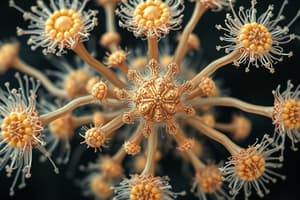Podcast
Questions and Answers
What distinguishes protists from other eukaryotic organisms?
What distinguishes protists from other eukaryotic organisms?
- They possess chloroplasts for photosynthesis.
- They exclusively reproduce sexually.
- They are a group that does not fit into the categories of fungi, animals, or plants. (correct)
- They have a similar reproductive process to bacteria.
What type of reproduction is most commonly seen in protists?
What type of reproduction is most commonly seen in protists?
- Sexual reproduction through gametes exchange.
- Asexual reproduction through binary fission. (correct)
- Fragmentation, followed by regeneration.
- Budding, leading to immediate offspring.
Which of the following is a consequence of declining phytoplankton populations?
Which of the following is a consequence of declining phytoplankton populations?
- Increase in marine biodiversity.
- Reduction in Earth's oxygen production. (correct)
- Boost in coral reef health.
- Decrease in zooplankton populations.
How do protists primarily move?
How do protists primarily move?
Why might malaria transmission increase with rising global temperatures?
Why might malaria transmission increase with rising global temperatures?
Flashcards
Kingdom Protista
Kingdom Protista
A diverse group of eukaryotic organisms that are not part of any other kingdom (plants, animals, fungi) and have traits from more than one category.
Phytoplankton
Phytoplankton
Microscopic algae that live in marine ecosystems and play a crucial role in producing oxygen.
Binary fission
Binary fission
The process by which a single-celled organism splits into two identical daughter cells.
Zooanthellae and Coral Symbiosis
Zooanthellae and Coral Symbiosis
Signup and view all the flashcards
Plasmodium
Plasmodium
Signup and view all the flashcards
Study Notes
Kingdom Protista
- Protists first appeared in the fossil record approximately 1.5 billion years after bacteria.
- Protists are eukaryotes, possessing a nucleus and membrane-bound organelles.
- They do not fit into other Kingdoms (fungi, animals, or plants).
- Most protists are microscopic and unicellular, but some are multicellular (e.g., kelp, seaweed).
Protist Characteristics
- Many are heterotrophs, meaning they obtain energy by consuming other organisms.
- Some protists are autotrophs, obtaining energy through photosynthesis.
- Most protists live in water; some live in the tissues of other organisms.
- Reproduction methods include asexual reproduction (e.g., binary fission) and sexual reproduction (e.g., exchanging gametes). Some reproduce through fragmentation.
- Protists can move using various mechanisms, including pseudopods (extensions of cytoplasm), flagella (whip-like structures), and cilia (tiny hair-like structures).
Importance of Protists
- Phytoplankton (microscopic algae) produce a significant portion of Earth's oxygen.
- Phytoplankton populations are declining due to warming ocean temperatures, which are also causing ocean acidification.
- Coral reefs depend on symbiotic relationships with zooxanthellae (protists). Loss of zooxanthellae can cause coral bleaching.
Parasitic Protists
- Malaria is an example of a parasitic protist caused by Plasmodium.
- Plasmodium is transmitted by the Anopheles mosquito, which thrives in tropical climates.
- Rising global temperatures could potentially expand the range of Anopheles mosquitoes and malaria, though this is a complex matter.
Studying That Suits You
Use AI to generate personalized quizzes and flashcards to suit your learning preferences.




